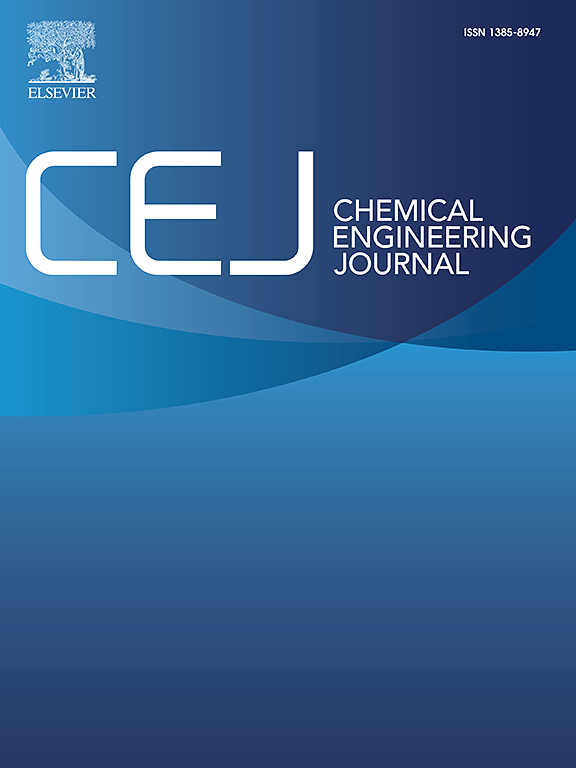Rapid-response electrochromic devices with self-wrinkling polyaniline for enhanced infrared emissivity modulation
IF 13.3
1区 工程技术
Q1 ENGINEERING, CHEMICAL
引用次数: 0
Abstract
Electrochromic devices (ECDs) based on polyaniline (PANI) can alter their optical properties reversely by varying applied voltages, showing great potential in infrared (IR) information concealment. However, the traditional ECD with a flat PANI layer tends to perform unsatisfactorily in IR emissivity regulation and response time, resulting in risks of information leakage and low transfer efficiency. To address these challenges, a wrinkled microstructure is incorporated into the PANI layer (PANI-W) of the ECD (ECD-W) through a self-wrinkling method. Theoretic simulations combined with experimental results verify that the PANI-W endows an enhanced antireflection effect and a more complete redox degree. As a result, the ECD-W exhibits an exceptional IR emissivity modulation (0.375) and a short response time (1.8 s/2.6 s), allowing it to realize a temperature modulation of 8.9 °C. Moreover, various patterned and anti-patterned ECDs-W are feasibly prepared without masks, and more complicated patterns can be realized by erasing the unnecessary part of PANI-W on the ECDs-W. Two encryption/decryption strategies based on these ECDs-W are presented to provide more secure ways for IR information concealment. This research offers guidance to achieve high-performance ECDs with more effective spectrum regulation and faster responses, showing great potential in thermal regulation and IR information protection.采用自起皱聚苯胺的快速响应电致变色器件,可增强红外发射率调制功能
基于聚苯胺(PANI)的电致变色器件(ECD)可通过改变外加电压反向改变其光学特性,在红外信息隐藏方面显示出巨大潜力。然而,传统的平整 PANI 层 ECD 在红外发射率调节和响应时间方面的表现往往不能令人满意,从而导致信息泄漏和传输效率低下的风险。为了应对这些挑战,我们通过自起皱方法在 ECD(ECD-W)的 PANI 层(PANI-W)中加入了起皱微结构。理论模拟与实验结果相结合,验证了 PANI-W 具有更强的抗反射效果和更完整的氧化还原度。因此,ECD-W 具有出色的红外发射率调制(0.375)和较短的响应时间(1.8 秒/2.6 秒),可实现 8.9 ℃ 的温度调制。此外,无需掩膜即可制备出各种图案和反图案 ECDs-W,通过擦除 ECDs-W 上 PANI-W 的多余部分,还可以实现更复杂的图案。基于这些 ECDs-W 提出了两种加密/解密策略,为红外信息隐藏提供了更安全的方法。这项研究为实现更有效的频谱调节和更快响应的高性能 ECD 提供了指导,在热调节和红外信息保护方面显示出巨大潜力。
本文章由计算机程序翻译,如有差异,请以英文原文为准。
求助全文
约1分钟内获得全文
求助全文
来源期刊

Chemical Engineering Journal
工程技术-工程:化工
CiteScore
21.70
自引率
9.30%
发文量
6781
审稿时长
2.4 months
期刊介绍:
The Chemical Engineering Journal is an international research journal that invites contributions of original and novel fundamental research. It aims to provide an international platform for presenting original fundamental research, interpretative reviews, and discussions on new developments in chemical engineering. The journal welcomes papers that describe novel theory and its practical application, as well as those that demonstrate the transfer of techniques from other disciplines. It also welcomes reports on carefully conducted experimental work that is soundly interpreted. The main focus of the journal is on original and rigorous research results that have broad significance. The Catalysis section within the Chemical Engineering Journal focuses specifically on Experimental and Theoretical studies in the fields of heterogeneous catalysis, molecular catalysis, and biocatalysis. These studies have industrial impact on various sectors such as chemicals, energy, materials, foods, healthcare, and environmental protection.
 求助内容:
求助内容: 应助结果提醒方式:
应助结果提醒方式:


